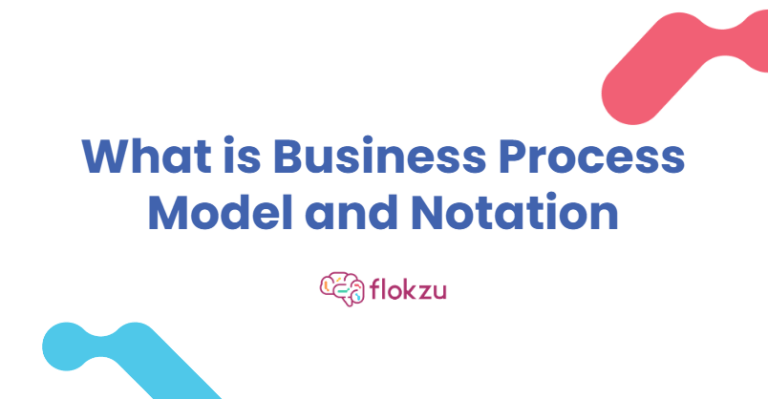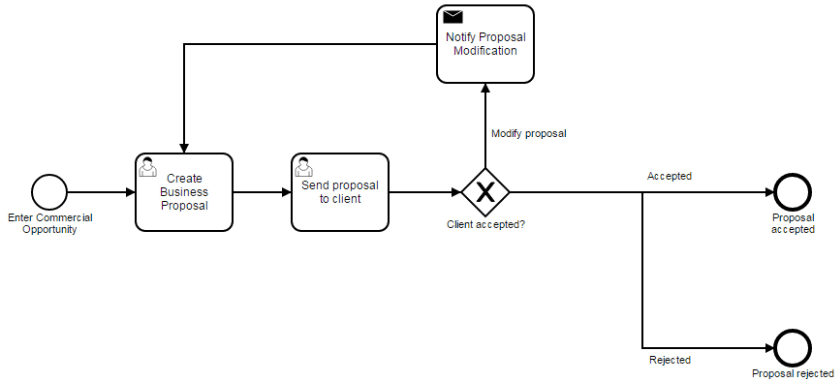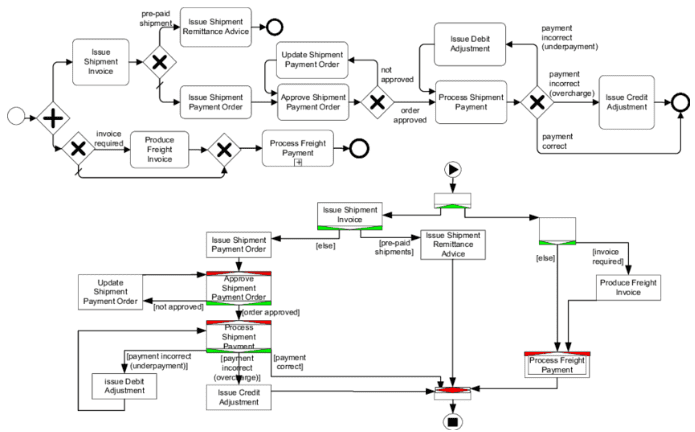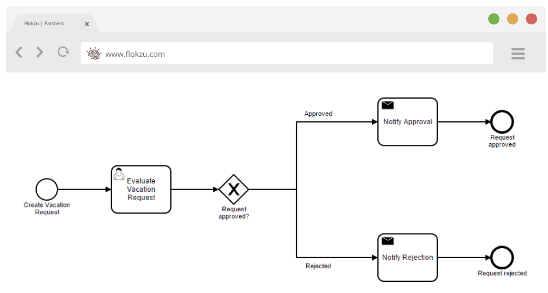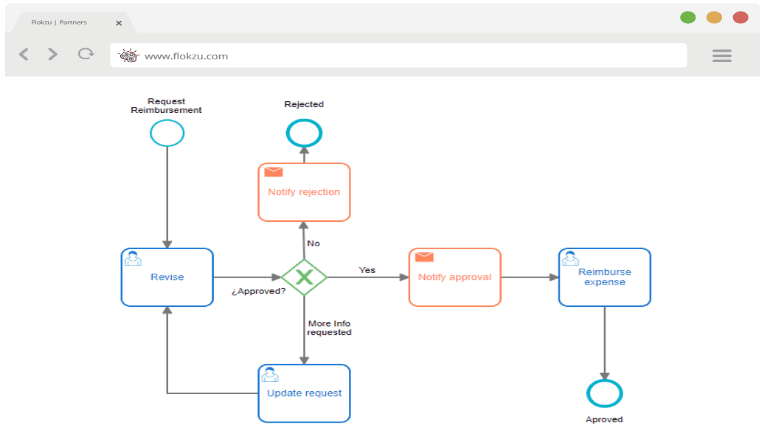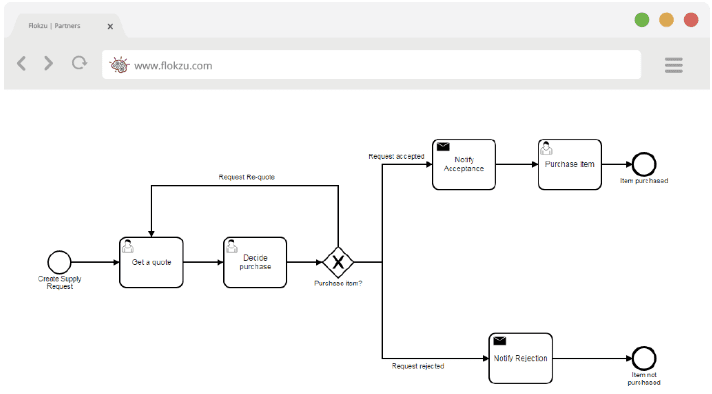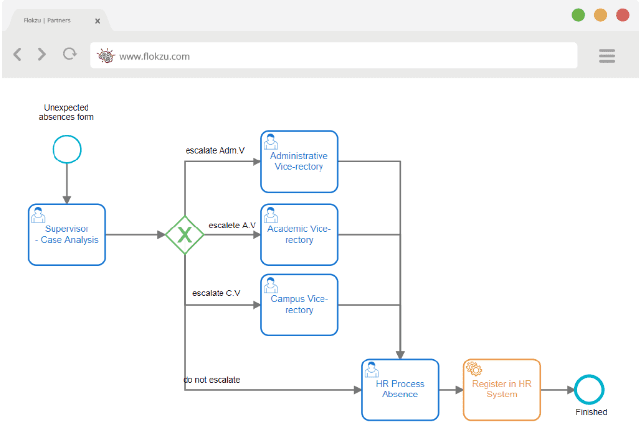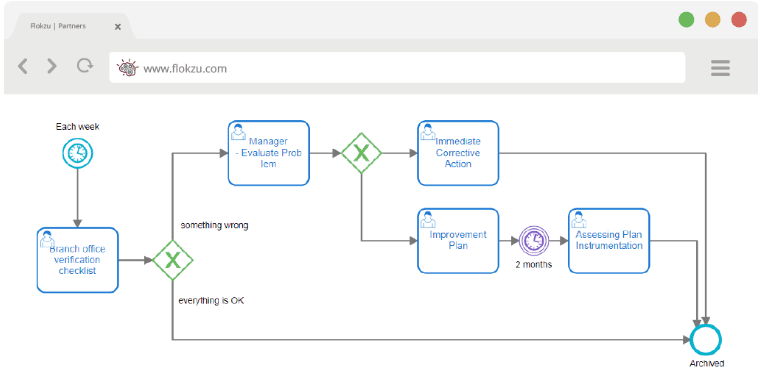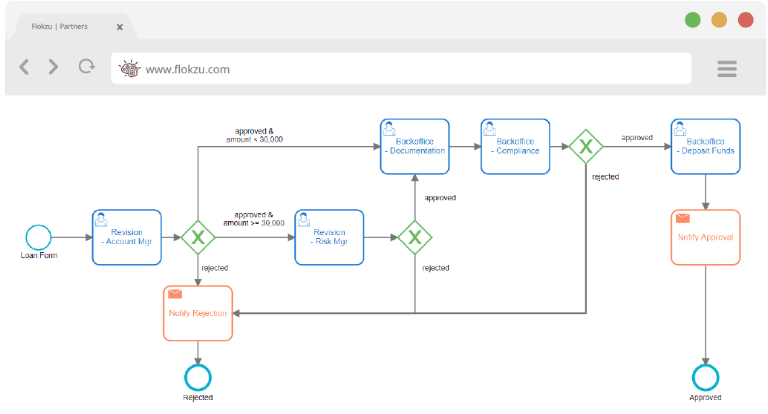What is Business Process Modeling and Notation?
If processes had an official language, that language would be BPMN. Business Process Modeling and Notation (BPMN) is an open standard graphical representation of a business’s processes and workflows. It is a flowchart that depicts the participants, options, and direction of said processes using standardized graphics and images. The BPMN is a standard propagated and published by the OMG.
The graphics used in Business Process Model and Notation are created to be intricate but simple to read. So simple that you wouldn’t need IT knowledge to understand it. Its simplicity makes it possible for executives, analysts, and tech implementation employees to use the same graphic to promote optimization and digitalization. Gone are the days when business processes needed thousands of documents and files.
Summarily, business process modeling and notation (BPMN) describes the steps involved in a business process, the participants of those processes, the business rules, and the documents involved.
If you would like to read only a summary of BPMN, click here.
When to Use BPMN
Regardless of how valuable a tool might be, knowing precisely when you should use it is far more essential.
When describing a business process, you can decide to do so through various methods. Usually, the most helpful is a pictorial diagram, this means using pictures to describe the different elements of the process. Although there are different pictorial diagram options, the business process model and notation (BPMN) standard is the most recommended.
As with flowcharts, you can use a BPM tool in numerous stages in a project’s lifecycle. For example, it might be employed at the beginning of your project to comprehend your current or “As-Is” state. Furthermore, as the project advances and begins to take shape, a “To-Be” model can be developed. Business Process Modeling and Notation is utilized when it’s crucial to visualize the steps involved in completing a particular project, the order in which they must be executed, and who is in charge of carrying out each task.
Here are some scenarios when you can use BPMN:
- Formally modeling the business process to make it easier to describe and understand for others (be it other professionals in the same organization or any other analyst). The person in charge of their business process knows all the steps and people involved. Still, it can be hard to communicate that information to others. BPMN helps to extract their information and translate it into a diagram.
- Executing those processes is a vital feature of the BPMN standard. You can use a BPMN engine to take the modeling and execute it without needing to code.
- Share, discover and improve your business processes. When you document how the process works, you can later share that information and discuss it with other team members. A vital functionality in many tools is allowing you to share the diagram easily. There is no doubt that a business model is indeed abstract. Still, this abstraction is ultimately needed to discuss and improve business processes.
BPMN Goals
After asking the question “What is BPMN?”, one might also be tempted to ask follow-up questions regarding what it’s for. So here we’ll present three primary goals of this tool.
- The primary goal of BPMN is to provide a set of artifacts that you can use to properly and fully describe a business process. Any business user can use it. It does not need computer developers’ help, coding, or any IT knowledge. Teammates from HR, Customer Success, and any department can use this technology.
- The second relevant goal in BPMN is how complete it is. What do we mean by this? It means that business users can model every business process, no matter how complex. They have a complete set of artifacts that allow you to describe their business process’s behavior.
- Lastly, being a worldwide standard. Most people who work with processes around the world know this standard. Most people who work with processes around the world know and use this standard.
BPMN Perspectives
As far as modeling languages go, none are as significant as BPMN. It has been widely adopted worldwide as the formal standard since before it was propagated by the Object Management Group (OMG). The introduction of BPMN changed the game regarding how business processes were modeled. It produced a more thorough standard for business process modeling by adopting a more extensive collection of symbols and notations for Business Process diagrams.
We can expect that BPMN will continue growing and being adopted worldwide. Whether we like it or not, we are entering a hyper-automated era. More and more organizations will use this notation to improve their competitiveness. In this hyper-automation environment, modeling business process is just the first step. Organizations need it to add intelligence to their processes, be it AI, chatbot, etc. First, you model every business, and then you can replace steps with intelligent artifacts.
How BPMN Works
As we’ve already stated, a BPMN diagram is a graphic diagram that allows business users to model and automate their business processes using different artifacts. While some artifacts are extremely easy to use, others can be more sophisticated and complex. The latter may require extensive training and an understanding of its intricacies and capabilities to utilize them more efficiently.
However, the wide accessibility of BPMN has made it so that you can create an efficient and detailed business process model, even without fully understanding the more complex artifacts. All that is required is that you know the fundamental basics of how BPMN works, and after this article, you’ll be an expert.
A generic business process model diagram.
A business process model made using simple artifacts and notations. This model showcases a Business Process Proposal process.
The BPMN language is based on flowcharts and graphical notations. The notations can be separated into four categories for diagramming:
- Flow Objects: Descriptive items used to describe a process, such as events, activities, and gateways. Processes are typically initiated by a start event, followed by activities/tasks and gateways (decision points), and terminated by an end event. Complex processes also incorporate sub-processes and intermediate events, as well as several sorts of gateways to demonstrate how the workflow proceeds through the diagram. For example, an exclusive gateway has only one movement choice. However, an inclusive gateway provides possibilities based on the selection made at the gateway.
- Connecting Objects: Symbols used to link flow objects such as message flows, sequence flows, and associations. The flows are illustrated by dashed or straight lines with arrows, whereas associations are represented by a dotted line to indicate that specific documents or artifacts are associated with a specific event or gateway.
- Swimlanes: These are containers that separate one set of activities from another, such as pools and lanes. Pools are the key actors in a process illustrated through a BPMN diagram. A distinct pool could represent a different organization, department, or consumer involved in the process. Lanes inside the pool depict the activities and flow for a certain job role or participant, identifying who is responsible for various steps of a process.
- Artifacts: Additional information about the workflow, such as data objects, groups, and annotations. A data object represents the data required for an activity, a group represents a logical grouping of activities, and an annotation describes what is happening in a specific area of the diagram. This is the information required or generated to carry out a business process. It includes data inputs, data outputs, data objects, and data repositories.
On the other hand, you can use all the artifacts to model very complex and advanced set behaviors of your processes. To execute this, BPMN provides several artifacts which can enable you to model very complex situations. As stated earlier, these artifacts are more complex to understand and use, but mastery of these artifacts can yield increased flexibility and versatility of your business process models.
Types Of BPMN Diagrams
BPMN diagrams can be either simple or complex diagrams that can depict the intricacies involved in either or both internal and external processes. They are generally classified into three categories. Which are:
- Collaboration Diagram: Shows interactions between two or more processes using more than one pool. The collaboration diagram focuses on the work done by each pool, and they can send messages to one another.
- Choreography Diagram: This shows interactions between two or more participants. The choreography diagram can be included in collaboration by adding tasks and sequences that define how the participants interact more thoroughly. Moreover, this diagram can be expanded with sub-choreographies.
- Conversation Diagram: A conversation diagram is a simplified version of a collaboration diagram, showing a group of related message exchanges in a business process. Furthermore, the conversation diagram can be further expanded with sub-conversations.
Aside from this formal means of classifying BPMN diagrams, other forms of classification are more business user-friendly. In this form, two categories are used to classify the BPMN diagrams. They are:
- Simple Diagrams: These diagrams are generally easy to comprehend because they use the basic artifact set. These artifacts include: the user task, the gateway, and the timer used to set up due dates or timed events, etc. With simple diagrams, even if the process model created is a large diagram, it still tends to be easy to comprehend.
A simple BPMN diagram using only a few sets of artifacts.
Complex Diagrams: On the other hand, complex diagrams use the complete set of artifacts that the BPMN standard provides. The advantage of using the artifacts that the BPMN standard provides is that it allows users to describe every business situation. They can depict virtually any business process of a company or organization, but it does so by sacrificing easy understandability. In this case, to understand the defined business process, the user must already have extensive knowledge of how all the artifacts work and interact with each other.
A complex BPMN diagram using a large variety of artifacts.
At Flokzu, we use simple diagrams and carefully select the most common subset of BPMN artifacts used and depicted in most business scenarios. This way, you can create and model a diagram for most administrative processes using just a few artifacts of the BPMN standard. By doing this, we’ve created an all-inclusive atmosphere for all business users to appreciate, discuss and improve their processes.
As we’ve mentioned, the possible downside could be that specific business processes that are too complex could be challenging to model. Regardless, we’ve made this decision because we are substantially accelerating the adoption and automation of business processes for everyone, not just IT professionals.
The Value Of BPMN
Due to its wide accessibility, the usefulness and impact of BPMN can be felt in almost every industry. As a result, the BPMN standard has become a universal language used to represent many business processes.
The value of BPMN can be seen in its helping organizations do the following:
- Reach faster conclusions on current and future processes through unambiguous models.
- Facilitate thorough analysis and improvement of operations all over the company.
- Provide a library of process flows, case definitions, and business rules to aid in the training of new employees.
From Marketing to the Finance and Sales department, the value of BPMN cannot be overstated. Take an onboarding process in the Human Resources department as an example.
Summarily, onboarding a new hire is usually a typical process. It can include introducing them to their role in a company, sharing material they need to read, see or sign, or any other specific task. Of course, several steps are involved when bringing someone on board to join a company, but using a BPMN, you can efficiently model a diagram depicting each step along the way to ensure it’s as successful as possible, making it an improvement for both the employer and the employee.
Business process model diagram depicting Onboarding process in Human Resources Department.
The value of BPMN can also be observed in the processes of a manufacturing company. Take the process of creating a new product as an example. This complex process involves numerous steps such as the design, funding, and marketing for said product, sourcing legal documentation, distribution of the product, etc. Moreover, some of these tasks need to be carried out simultaneously.
Using a BPMN diagram, you will have this complex process aligned to make all the steps involved streamlined and easier to perform. In addition, automating this process will help the organization identify any operation bottlenecks so that sound measures are made to fix them. All this can result in increased business operation and organization effectiveness and efficiency.
Furthermore, BPMN diagrams assist teams in creating the XML (Extensible Markup Language) documents required to conduct various processes, such as contract approvals or monthly financial report reminders.
BPMN Elements And Symbols
Throughout this article, we have explained that BPMN is a complete standard comprising a full set of artifacts. Here’s a complete list of the artifacts:
Elements
Description
Notation
Event
An Event is something that “happens” during a Process or Choreography. These Events affect the model’s flow and usually have a cause (trigger) or an impact (result). Events are circles with open centers that allow internal markers to distinguish between distinct triggers or outcomes. They are classified into three sorts based on when they influence the flow: start, intermediate, and end.
Activity
An Activity is a broad term for a corporation’s activity as part of a Process. It can either be atomic or non-atomic (compound). A Process Model contains two types of Activities: Sub-Process and Task. Both ordinary Processes and Choreographies make use of Activities.

Gateway
A Gateway is used in a Process and a Choreography to govern the divergence and convergence of Sequence Flows. As a result, it will determine path branching, forking, merging, and joining. In addition, internal indicators will indicate the type of behavior control.

|
Sequence Flow |
A Sequence Flow is used to depict the sequence in which Activities in a Process and Choreography are done.
Message Flow
A Message Flow depicts the flow of messages between two Participants who are both ready to transmit and receive them.
Association
An Association connects information and artifacts to graphical elements in BPMN. An arrowhead on the Association indicates a flow direction (e.g., data) when appropriate.
Pool
A Pool is the graphical representation of a Participant in a Collaboration.

Lane
A Lane is a sub-partition within a Process and can extend the entire length of the Process, either vertically or horizontally. Activities are organized and classified using lanes.

Data Object
Data Objects contain information about the activities that must be completed. Data Objects can represent either a single object or a group of objects.
Message
A Message represents the content of a communication between two Participants.
Group (a box around a group of objects within the same category)
A Group is a collection of graphical elements that belong to the same Category. This grouping does not affect the Sequence Flows within the Group.

Text Annotation (attached with an Association)
Text Annotations allow a modeler to supply additional text information to a BPMN Diagram reader.

Flow Dimension (e.g. Start, Intermediate, End)
Start
Intermediate
End
A Start event indicates where a particular Process or Choreography starts.
An intermediate event occurs between a Start event and an End event.
An End event indicates where a Process or Choreography ends.

Task (Atomic)
A Task is an atomic Activity that is part of a Process. A Task is utilized when the work in the Process is not broken down to a finer level of Process detail.

Process/Sub-Process (non-atomic)
The Sub-Process boundary is extended, and the details (a Process) are viewable within it.
See next image
Normal Flow
Normal flow refers to Sequence Flow lines that do not begin with an Intermediate Event tied to an Activity’s boundary.
Uncontrolled Flow
Uncontrolled flow is defined as flow that is not influenced by any circumstances and does not pass through a Gateway.
Conditional Flow
A Sequence Flow can have a condition Expression that is tested at runtime to determine whether the Sequence Flow will be used. If the conditional flow is exiting from an Activity, the Sequence Flow will have a mini-diamond at the start of the connection (see figure to the right). If the conditional flow is coming from a Gateway, the line will be devoid of a mini-diamond (see figure in the row above).
Default flow
The Default condition flow is one form of flow for Data-Based Exclusive Gateways or Inclusive Gateways. This flow will only be used if all the other outgoing conditional flows are not true at runtime. A diagonal slash will be inserted to the beginning of the connector in these Sequence Flows (see the figure to the right).
Message Flow
A Message Flow depicts the flow of messages between two Participants who are both ready to send and receive them.
Fork
The term “fork” in BPMN refers to the division of a path into two or more parallel paths (also known as an AND-Split). It is a location in the Process where operations can be carried out concurrently rather than sequentially.
There are two options:
- Multiple Outgoing Sequence Flows can be employed (see figure top-right). This illustrates “uncontrolled” flow, which is the preferred option in most instances.
- A Parallel Gateway can be employed (see figure bottom-right). This is rarely used, usually in conjunction with other Gateways.

Join
The term “join” in BPMN refers to the joining of two or more parallel paths into one path.
A Parallel Gateway is used to demonstrate the connection of multiple Sequence Flows.
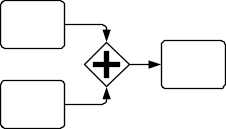
Decision, Branching Point
Decisions are Gateways within a Process or a Choreography where the flow of control can take one or more alternative paths.
See next image
Event-Based
This Decision illustrates a branching point in the Process or Choreography where Alternatives are based on an Event that occurs at that time. The specific Event, usually the receipt of a Message, defines which of the pathways will be taken. Other sorts of Events, such as Timer, can be used.
There are two options for receiving Messages:
See next image
- Tasks of Type Receive can be used (see figure top-right).
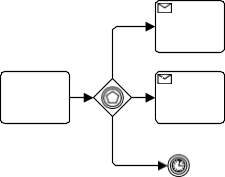
- Intermediate Events of Type Message can be used (see figure bottom-right).
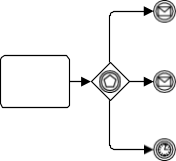
Merging
|
The term “merge” in BPMN refers to the exclusive combination of two or more pathways into one path (also known as an OR-Join). A Merging Exclusive Gateway is used to demonstrate the combination of numerous Sequence Flows (see upper figure to the right). If all the incoming flow is alternative, no Gateway is required. (see lower figure to the right). |

Looping
Within a Process, BPMN provides two techniques for looping.
See next image
Activity Looping
The properties of Tasks and Sub-Processes determine whether they are repeated or executed only once. Loops are classified into two types: standard and multi-instance. At the bottom-center of the activity, a little looping indicator will be presented.

Sequence Flow Looping
Loops can be built by connecting a Sequence Flow to an “upstream” object. Upstream objects have an outgoing Sequence Flow that leads to a number of subsequent Sequence Flows, the final of which is an incoming Sequence Flow for the original object.

Transaction
A transaction is a Sub-Process that is backed by a particular protocol that ensures that all parties involved agree on whether the activity should be performed or terminated. The attributes of the activity will decide whether the activity constitutes a transaction. A double-lined boundary indicates that the Sub-Process is a Transaction.

Off-Page Connector
This object, which is typically used for printing, shows where a Sequence Flow exits one page and then resumes on the next. A Link Intermediate Event can be used as an Off-Page Connector.

Given the flexibility and diverse options that BPMN provides through the inclusion of numerous artifacts, managing and comprehending such a diagram in which all the elements are used becomes extremely difficult. These artifacts all have different uses, properties, and behaviors. As such, you would need to know how every artifact functions and interacts with each other to grasp and utilize the diagram fully. Only a few (trained professionals) would be able to understand a diagram that uses all the elements previously mentioned.
Although BPMN engines are pretty versatile in modeling a process, most of them cannot run and execute all the BPMN artifacts. In Flokzu, we mitigate this steep curve by carefully selecting and choosing a subset of these most useful artifacts to model and automate an administrative workflow. We believe simplicity is the key when trying to model and automate a process.
BPMN Examples
Due to its versatility and efficacy, BPMN has permeated into the core of almost every industry. A few sectors which have made the BPMN model a priority in their process management include: Human Resources, Health, Education, and Finance. Standard real-world applications of BPMN for each sector is shown below:
HUMAN RESOURCES – Leave of Absence Application
The vacation request process is one of the most commonly used in HR departments worldwide. However, this doesn’t make it less important or easier to execute. On the contrary, not having this process well automated can mean a lot of time and resources wasted in unnecessary steps. Automating this process with Flokzu helps the organization better plan for absences. And employees have a user-friendly tool to request, track and know the resolution of their request, adapting the process to the company’s needs. Make Flokzu your number one choice for creating a more efficient business process.
HUMAN RESOURCES – Request for Per diems or advances
This is one of the most common processes in any organization, specifying the request for advances or per diems. Automating this process will mean much less paperwork in various departments, leaving time to work on more relevant and complex tasks and leaving this process on autopilot.
HEALTH – Request for supplies
Automating the supply request process gives team members a formal way to request different items. As a result, the request is remembered in someone’s inbox when it is too late. In addition, a formal workflow allows you to identify which stage or task is being performed. This will increase efficiency and leave more time for complex and essential tasks.
HEALTH – Medical Technology Imports
In healthcare institutions, it is crucial to keep up to date with cutting-edge technology. Therefore, on several occasions, we have had to launch the medical technology acquisition process. Having this process well automated allows the company to operate with a high degree of agility. It also ensures that the request goes through the necessary stages, depending on the needs of the company or even the commercial department.
EDUCATION – Notice of unexpected absence
Having an easy way to record an unexpected absence gives you more time to organize who will cover for the absentee or any other coordination needed. This will allow the organization to function with a high degree of agility.
EDUCATION – Special activities coordination
Often, in educational institutions, special activities and events must be organized and coordinated across numerous departments. This process involves enormous communication and synergy between multiple sectors and people involved.
Automating this process with a collaborative tool allows this exchange of information and resources to be as smooth and efficient as possible. In a single process, all the data can be collected in the custom-made form, and then all the attachments needed to perform each task can be added.
FINANCE – Branch office inspection
The process will be triggered automatically and periodically, for example, once a week. In addition, you can include a checklist that the inspector will fill out each time he inspects a branch. For instance, you could check different items on a single checklist, such as hygiene, communications, marketing material, or building maintenance. Also, the inspector could include photos of the location in that digital checklist. The form will automatically save the location of when it was completed for a better audit process. You can accomplish all of this with the same BPM tool. Flokzu allows this and much more, since we present a simplified version of the process. Try Flokzu today.
FINANCE – Credit or Loan request
This typical financial institution process can be automated and used from any branch office. It allows all stakeholders access to up-to-date information, thus providing better customer service. This process gathers all necessary elements, such as approvals, authorizations, and comments. When the process is completed, you will have a complete audit trail that will provide accurate information to improve process performance.
These are four of the leading industries that have found the most value when modeling their processes with BPMN and automating said processes using a BPMN Engine.
Who does business process modeling?
The primary purpose of BPMN is to serve business users universally and not be a tool exclusively for IT staff or programmers. This is key because, unlike programmers, business users possess deep and extensive knowledge about the business and its numerous processes that keep the company running smoothly. No one understands the business processes as much as the business user, so it makes sense that they should be in charge of modeling their processes. Hiring or consulting an IT specialist or programmer whenever a model needs to be created will slow down the process and potentially introduce more errors.
On the other hand, if the business user has the knowledge to create the BPMN diagram independently, this will result in a faster, streamlined process that will save time and money. Moreover, the business user can easily update the model in the future because they were the ones who solely created the model in the first instance. BPM modeling aims to create a cycle of continuous improvement. As such, if a business user understands the BPMN method, they can continue this life cycle while saving time and costs and increasing their company’s efficiency and competitiveness in that particular market.
To achieve this continuous improvement, it is essential to keep the BPMN diagram simple, and that is precisely our perspective at Flokzu. We carefully selected a subset of artifacts from the overall set offered by BPMN to make business process modeling easier to understand.
By using this standard offered by Flokzu, you can learn and begin to create your version of the process model in just a few hours. Most importantly, you can automate this model into a BPMN engine. This way, whenever you get a Key Performance Indicator (KPI) and identify an improvement opportunity, you will be able to independently improve and introduce the changes into the process to make it better. All without the consultation of an IT specialist or programmer. Try Flokzu today.
Purpose and Benefits
Workflows in numerous companies and sectors worldwide that have used the BPMN standard have shown this to be a very beneficial tool. Here are the main benefits you can obtain:
One of the main benefits of BPMN is that it creates an avenue for you as a business user to properly manage your company’s knowledge. BPMN allows you to create a formal, diagrammatic representation of the processes involved in running your organization. Furthermore, it helps you to give otherwise intangible concepts a more solid and intractable format, giving the BPMN meaning. Now these processes can easily be shared and discussed between your company members.
Another huge benefit offered by BPMN is that it allows you to automate any and every administrative workflow using a standard that anyone can understand. By using the subset that we at Flokzu carefully select alongside our BPMN engine, you can be sure to create and automate your BPMN workflow as quickly as possible. This allows you to complete the cycle of modeling and automation in just a few hours.
Aside from just representing your business processes in a simple diagram, you can also run and update this diagram as time progresses, giving more life and depth to the diagram. When you model your process and create a BPMN diagram using Flokzu, you have a living, breathing process in which you can introduce updates and modifications seamlessly, leading to increased knowledge management within the company.
By offering adequate precision and clarity in the order of business activities, BPMN bridges the gap between business intention and implementation. Diagrams are often more straightforward to understand than text. BPMN makes it easier to communicate and work together to achieve the objective of an effective process to yield high-quality results. As a result, you have a well-organized workflow between everyone involved in the hierarchy of that organization.
Frequently Asked Questions
What is BPMN?
The Business Process Modeling Notation (BPMN) is a diagrammatic representation of the steps involved in a business process. BPMN represents the complete cycle of a business process. BPMN was created primarily to manage the sequence of processes and the communication flow between different process participants in a linked set of activities.
Is BPMN a flowchart?
Yes and No. BPMN (Business Process Modeling Notation) is a flow chart method for modeling the steps of an intended business process from beginning to end. In this light, one may think BPMN and flowcharts are the same, but that would only partially be true. Flow charts have yet to evolve in terms of notation. In contrast, BPMN is a notation created to advance business process modeling. Using a standard like BPMN, you have a system of rules that serve as the foundation for modeling business processes that are understandable to a broader audience. Unlike regular flow charts that lack an agreed-upon set of modeling principles. As such, BPMN is a type of flowchart.
How is BPMN different from UML?
The Unified Modeling Language (UML) is used to model software systems. In contrast, the Business Process Modeling Notation (BPMN) models entire business processes. Summarily, the fundamental difference between UML and BPMN is one of perspective: UML is object-oriented, whereas BPMN is process-oriented. As a result, BPMN is generally applicable to both IT and business. In contrast, UML is better suited to building IT systems and less suitable for process improvement.
Is BPMN easy to learn?
The learning curve for BPMN generally depends on the particular approach you take. For example, trying to learn BPMN by using all the symbols and artifacts available will certainly be a difficult task. On the other hand, at Flokzu, we only select a subset of the most important symbols to make business process modeling as straightforward as possible, while still creating efficient and thorough models.
What are the main categories of BPMN?
The four main categories of BPMN are Flow Objects (e.g., activities, events, gateways), Connecting Objects (e.g., sequence flow, message flow), Swimlanes (e.g., pools), and Artifacts (e.g., annotation, group)
How to create a BPMN diagram?
Creating a BPMN diagram can be a tricky process. Follow this step-by-step guide to create your very own BPMN diagram.
Step 1: Define the Scope and Purpose of Your BPMN Diagram
Regardless of the style of the diagram you create, it is critical to understand who it’s for and how they will utilize it. This will assist you in striking a balance between including enough detail to be thorough and helpful without overwhelming your audience.
Step 2: Draw in Pools and Swimlanes
After you’ve defined the scope of your diagram, consider who will be involved in the process. Pools are the larger sections of your design and often represent departments or even entire organizations that carry out an operation. Swimlanes divide those pools into smaller groups or roles that accomplish tasks to keep the process moving.
Step 3: Add the Start Event and Work Forward
Every BPMN diagram contains Start and End event symbols. These are plain, unfilled circles. If your diagram has numerous pools, you’ll need a Start and End icon in each one.
Step 4: Add Activities to Each Swimlane
The tasks that occur throughout the process are referred to as activities. For example, consider what people do to get from point A to point B in a particular operation and add each step to its corresponding swimlane, from left to right.
Step 5: Add Gateways and Events Between Activities
You should add gateways at points where the process splits or can take numerous paths. As a simple way to assess your work while adding gateways, there should never be several arrows flowing from one activity.
Step 6: Add or Edit Connectors
You may have sketched arrows as you added activities, gateways, and events. Draw in any outstanding connectors and finish with an end event icon to ensure you’ve completed the entire process.
Step 7: Proofread and Annotate
This step involves going over the diagram you have created. In this step, it would be best to get extra help to review the diagram for potential errors. In addition, you can show your diagram to others at this step to see if it is understandable. The feedback gotten from your audience will aid you in planning your next course of action.
Step 8: Publish, Share, and Iterate
Save and download your completed diagram if you used an online diagramming tool such as Gliffy. As people raise concerns or your business changes, you can return to this diagram to update the flow.
You can also schedule a work session here to model a real-life process in your organization together

